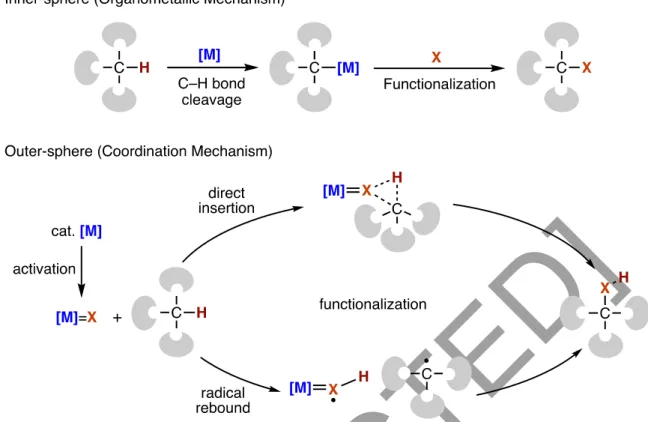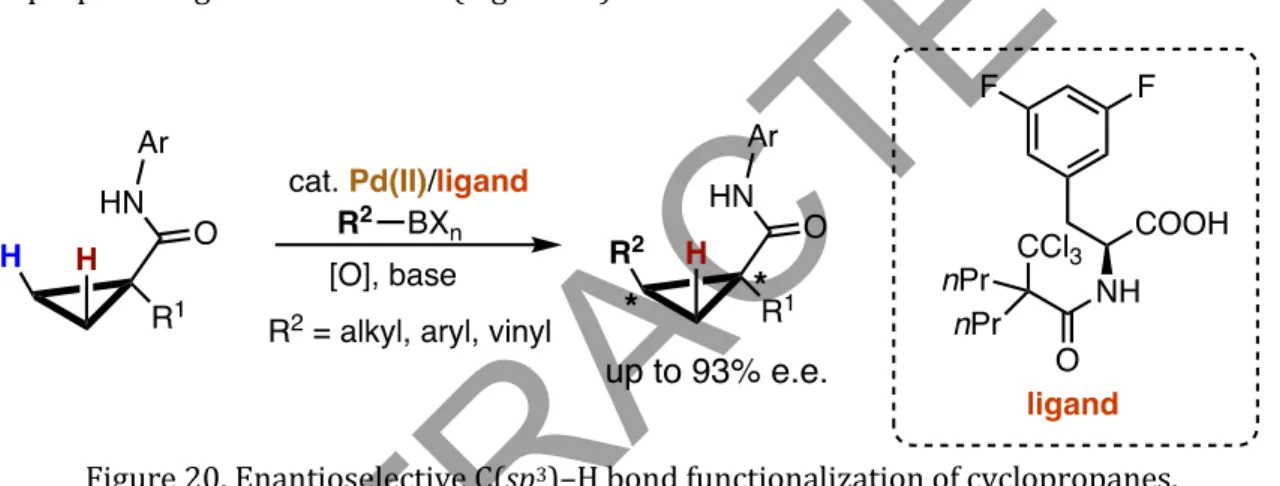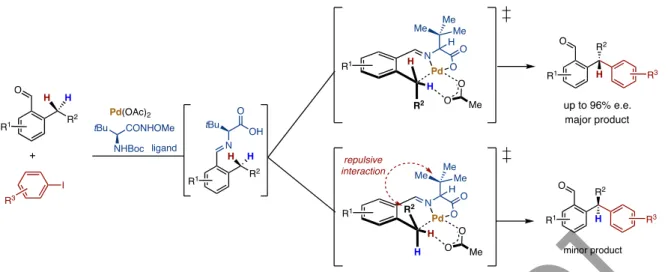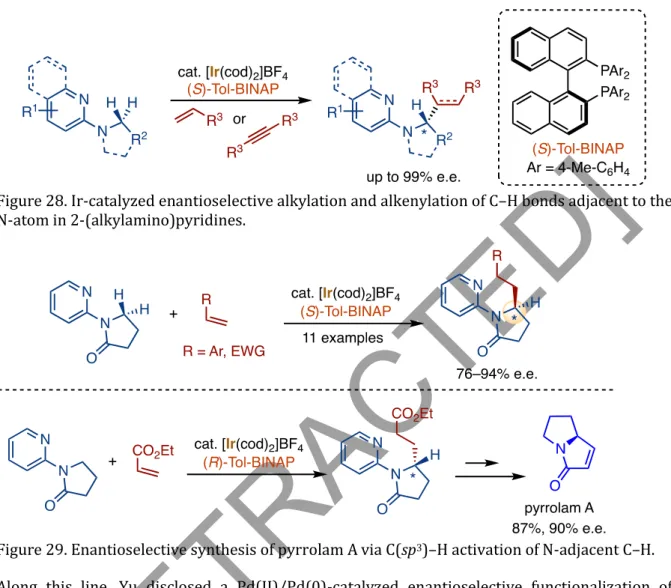Overcoming the challenge of site selectivity due to the ubiquitous nature of C–H bonds is at the forefront of C–H bond activation chemistry. A key disadvantage often cited against the directed functionalization of C–H bonds is the need for the installation of directing groups and the subsequent removal of these moieties after the reaction. These two classes differ in the way the metal catalysts interact with the target C–H bonds.
Potential problem arises from overoxidation due to the weaker nature of C-H bonds in the oxidized product. Cleavage of C–H bonds by hydrogen atom abstraction generates a carbon-centered (alkyl) radical, typical for oxidation reactions, and the recombination of this radical species with a metal complex or a variety of reagents can deliver desired functional groups to the alkyl group (Figure 7a). The selectivity of reactions proceeding via the formation of metal-carbon (M-C) bonds depends on the relative strengths of the M-C bond in the resulting organometallic intermediates.
Reactions that occur via M-C bond formation often favor reactivity over aryl over alkyl C-H bonds, and primary over secondary or tertiary C-H bonds. Although the functionalization of C(sp3)–H bonds has been less studied due to the thermodynamic and geometric properties of the tetrahedral carbon center, numerous strategic techniques have emerged to circumvent the chemical inertia of C(sp3)–H bonds. This was immediately followed by a report on the amide-directed Pd(0)-catalyzed intermolecular arylation of C(sp3)-H bonds (Figure 9) achieved with PR3/ArI combination (Wasa et al., 2009).
The same and co-workers have demonstrated direct oxidative cross-coupling of C(sp3)-H bonds and alkenes via a double C(sp3)-H activation, Figure 11b, at the position adjacent to the amide nitrogen of the leading group and Bond Formation C-C is accomplished under neutral catalytic conditions (DeBoef et al., 2004).
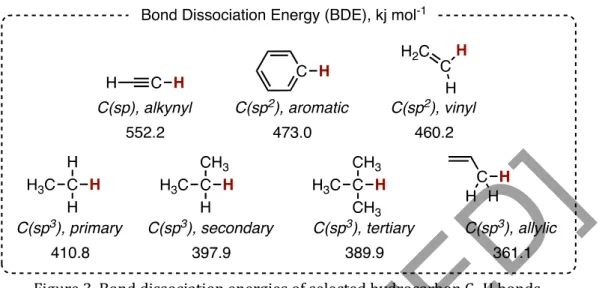
RETRACTED]
This work was immediately followed by a report on the arylation of cyclobutyl C(sp3)–H bonds by systematic tuning of the chiral ligand leading to the desymmetrization of enantiotopic carbon atoms in cyclobutyl derivatives (Xiao et al., 2014). Excellent enantiocontrol of the cross-coupling of methylene β-C(sp3)–H bonds in cyclobutane carboxylic acid derivatives with arylboron reagents was achieved by the development of chiral mono-N-protected α-amino-O-methylhydroxamic acid ligands, which form a chiral complex with the Pd(II ) center (Figure 21). Following this development, Yu and colleagues also demonstrated an enantioselective desymmetrization in acyclic systems (Xiao et al., 2014), where terminal methyl-C(sp3)-H bonds were functionalized in amide using a chiral hydroxamic acid ligand (Figure 22) .
Activation of enantiotopic methylene C(sp3)–H bonds remains one of the most difficult synthetic challenges to date. In addition, methylene C–H bonds are characterized by a high heterolytic bond dissociation energy, which makes their transformation thermodynamically upward (Saint-Denis et al., 2018). In the case of methylene C–H bonds, the catalytic system must be carefully designed to discriminate between two enantiotopic C–H bonds on one carbon center.
This serves predominantly as a transition directing group affecting the enantioselective arylation of benzylic C–H bonds in aromatic aldehydes and ketones (Zhang et al., 2016). This methodology was based on the binding of transient aldehyde imine intermediates to Pd(II). ) center using a ligand derived from amino acids (Figure 26). Duan disclosed the use of chiral phosphorus amides in the enantioselective arylation of the secondary C(sp3)–H bonds of 8-aminoquinoline amides, yielding a series of β,β-diaryl carboxylic derivatives in moderate to good enantiomeric ratios (Yan et al., 2015). ). This report is the first to use a chiral phosphorous amide to control the stereoselectivity of the C–H bond cleavage step during a C–H activation reaction (Figure 27). The functionalization of methylene C–H bonds adjacent to the heteroatom has been thoroughly investigated by various groups.
Pyridine and 2-quinoline were identified as suitable targeting groups for this transformation that activate and functionalize the methylene-C-H bonds -to-N-atom of the amino group of the substrates (Figure 28). Ir-catalyzed enantioselective alkylation and alkenylation of C-H bonds adjacent to the N atom in 2-(alkylamino)pyridines. Along this line, Yu revealed a Pd(II)/Pd(0)-catalyzed enantioselective functionalization of thioamines with boronic acids via the activation of C-H bonds in the substrate adjacent to the N atom (Jain et al., 2016). This functionalization made allows the synthesis of essential motifs containing ethylamines, azetidines, pyrrolidines, piperidines, azepanes, indolines and tetrahydroisoquinolines.
The use of chiral phosphoric acid ligand showed efficient coupling of activated methylene C-H bonds leading to their differentiation in a chiral environment (Figure 30). Among the substrate categories for C–H bond functionalization outlined in Figure 25 , unbiased or unactivated C–H bonds in acyl substrates remain the most challenging target for C– . Houk, Yu and co-workers reported the arylation of - methylene C(sp3)-H bonds in amide derivatives (Figure 31) using a chiral aminoethylquinoline ligand (Chen et al., 2016). work is the extended ligand design that effectively discriminates between the methylene C–H bonds that enable the Pd(II)-catalyzed C–.

C–H ACTIVATION FOR THE CONSTRUCTION OF C–B BONDS
In striking contrast to the catalytic borylation of C(sp2)-H bonds in alkene, arene, or heteroarene systems, the catalytic borylation of C(sp3)-H bonds has contracted less progress. Catalytic borylation of C-H bonds with high efficiency has been the subject of many fundamental research efforts. As a follow-up to this report, Suginome later reported the borylation of C(sp3)-H bonds to methyl groups (Ohmura et al., 2014) in an isopropyl moiety of substrates that do not have any directing group (Figure 39).
Another Pd-based system was reported by Yu and co-workers that has the efficient borylation of carboxylic acid-derived amides through ligand acceleration (He et al., 2016). In this work, quinoline-based ligands were shown to promote the C(sp3)-H borylation of methyl-CH bonds as well as methylene-CH bonds in a wide variety of cyclic amide substrates, including cycloalkane derivatives (Figure 41). Sawamura succeeded in 2009 in the development of an iridium-catalyzed directed borylation of aryl-CH bonds ortho to ester, amide, sulfonate, methoxy, and chlorine directing groups using a new heterogeneous silica-supported monophosphine ligand ( Kawamorita et al., 2009).
Following the report on the borylation of the aryl C–H bond, Sawamura and co-workers reported the direct C(sp3)–H borylation of amides, ureas, and 2-aminopyridine derivatives. Sawamura also disclosed the heteroatom-directed C–H borylation of cyclopropanes and cyclobutanes using a heterogeneous system ( Murakami et al., 2014 ). The regioselectivity was determined by the bond dissociation energy (BDE) of the C–H bond, which showed a high selectivity towards the borylation of alkyl groups.
Despite the strategies that have been developed to borylate the C(sp3)-H bond, enantioselective C(sp3)-H borylation remains non-progressive. Yu and co-workers initially attempted a Pd-catalyzed enantioselective borylation based on their previous work on the borylation of methylene C–H bonds using quinoline ligands. The protocol successfully enabled the asymmetric borylation of C(sp3)–H bonds in cyclic amides including cyclopropanes, cyclobutanes, and cyclohexanes with a high degree of enantioselectivity.
For example, the borylation of 2-aminopyridine derivatives with bis(pinacolate diboron) under rhodium catalysis gave the corresponding secondary. Accordingly, the iridium-catalyzed asymmetric borylation of internal methylene C-H bonds in 2-alkylpyridine and 2-alkyl-1,3-azole derivatives (Figure 51) proceeded with excellent enantioselectivity and afforded -chirogenic alkyl boronates using a triisopropylsilyloxy (TIPS)-modified BINOL-based monophosphite ligand (R,R)-L* (Reyes and Sawamura, 2020). The borylation protocol was successfully applied to the catalyst-controlled site- and stereoselective C(sp3)-H borylation of an unprotected dipeptide compound, allowing a remarkably streamlined synthesis of the anti-cancer drug molecule bortezomib.
Recently, Sawamura and co-workers revealed highly enantio- and site-selective catalytic borylation of distant C(sp3)–H bonds γ to the carbonyl group in aliphatic carboxylic acid derivatives (Reyes et al., 2020). Substrate scope (a) of the catalytic asymmetric borylation of distant C–H bonds in aliphatic amides and esters and the corresponding calculated transition state (b) leading to the major enantiomer.
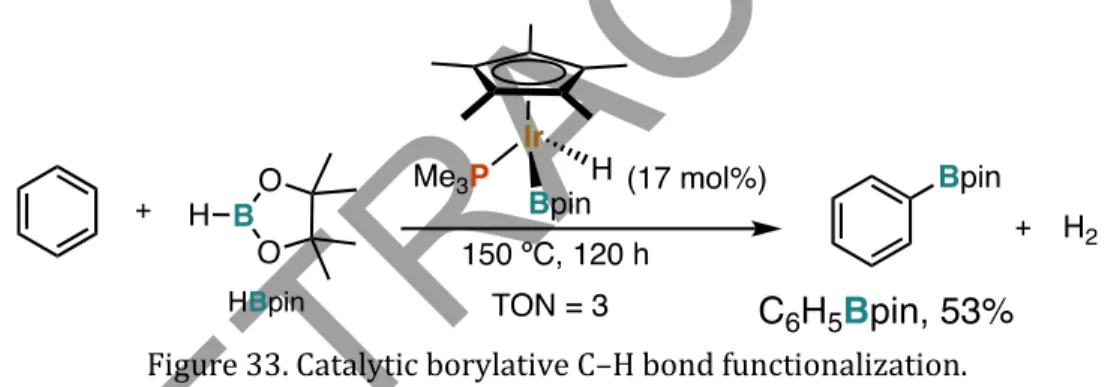
OUTLOOK AND FUTURE PERSPECTIVE
Furthermore, the versatile synthetic utility of enantioenriched γ-borylcarboxylic acid derivatives was demonstrated opening the possibility for the development of strategic synthetic tools for constructing structural diversity from readily available starting materials. Quantum chemical calculations for distant C–H borylation support an enzyme-like structural cavity formed by the catalyst components, which binds the substrate through multiple noncovalent interactions as shown in the three-dimensional (3D) representation in Figure 55b. One of the naphthalene rings of the (R,R)-L* monophosphite ligand has interactions not only with the pyridine moiety but also with the ortho-phenylene linker of the receptor ligand, while the substrate is bound in the cavity not only through hydrogen bonding with the urea moiety, but also through C(sp3)–H···O interactions and London dispersion interactions in general contributing to substrate binding in the catalytic cavity.
These properties complement those of natural enzymes, which have complex active sites for substrate binding. Interactions within this pocket effectively position the substrate and bring the target site into close proximity to the catalytic center.
ACKNOWLEDGEMENT
ABOUT THE AUTHORS
Alkane C-H activation and functionalization with homogeneous transition metal catalysts: a century of progress - a new millennium ahead. Synthesis of primary and secondary alkyl boronates by site-selective C(sp3)–H activation with silica-assisted monophosphine–. Hydrogen bond-accelerated meta-selective C-H borylation of aromatic compounds and expression of functional group and substrate specificities.
Site-selective and stereoselective C(sp3)-H borylation of alkyl side chains of 1,3-azoles with a silica-supported monophosphine-iridium catalyst. Iridium-catalyzed borylation of sterically hindered C(sp3)-H bonds: remarkable rate acceleration by a catalytic amount of potassium tert-butoxide. PdII-catalyzed enantioselective activation of C(sp2)-H and C(sp3)-H bonds using mono-protected amino acids as chiral ligands.
Recent progress in enzymatic functionalization of carbon-hydrogen bonds for the green synthesis of chemicals.
